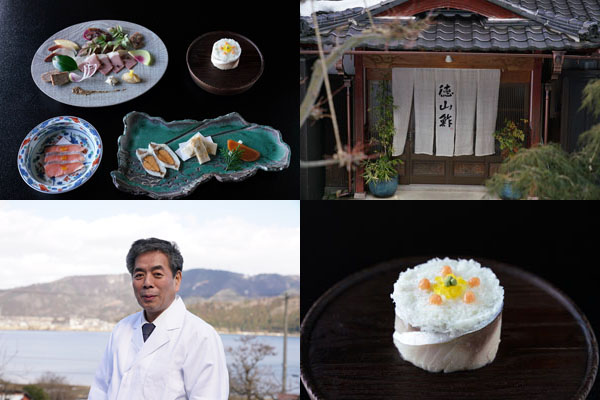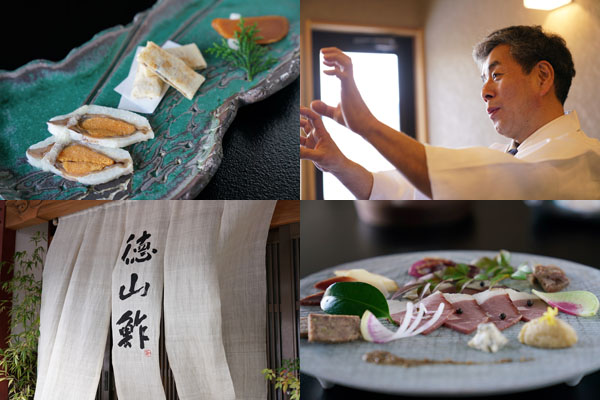Tokuyama Zushi: Renowned Fermented Food in Shiga
Mar 15,2017
Tokuyama Zushi: Renowned Fermented Food in Shiga
Mar 15,2017
Regular Japanese meals have long been enriched by many fermented foods including miso, soy sauce, vinegar, mirin rice wine, and fermented natto soybeans. Fermented foods and their umami flavorings are produced by the actions of endemic microorganisms and offer a host of benefits to the human body. Fermented foods, moreover, represent the crystallization of Japan’s great wisdom produced by our ancestors. In this series, we present the people and establishments connecting the fermented foods of today to future generations as well as fermented food recipes. For Part 8, we visited Tokuyama Zushi, a renowned fermented food restaurant located near Lake Yogo in northern Shiga.
▶Tamana Shokudo: Aoyama’s Brown Rice & Vegetable Spot
▶Oizumi Kojo Nishiazabu: Tokyo’s Kombucha Café

Lake Yogo, located north of Lake Biwa — Japan’s largest lake, is a small lake with a circumference of just six kilometers. Despite its diminutive size, the lake is a treasure trove of natural ingredients. Nigorobuna [round crucian carp], the prime ingredient of the local nare-zushi [marinated fish pressed into rice] delicacy, wild eels, ayu sweetfish, Biwa trout, and other species are caught in the lake. The surrounding slopes and woodlands offer a variety of wild game, including wild boar, bear, deer, and duck, as well as an abundance of wild vegetables and mushrooms.
Tokuyama Hiroaki, owner of Tokuyama Zushi, is a leading figure in the world of fermentation cuisine and has been featured in the popular documentary series Jounetsu Tairiku, which follows opinion leaders in their respective fields. He added “Zushi” to the name of his restaurant, representing the traditional way of making sushi with fermented fish, where he continues to pursue the attractions of fermented foods.
“When I was working as the head chef at an inexpensive Lake Yogo hotel run by the local government, I had a fateful encounter with Dr. Koizumi Takeo, who was then the Director of the Yogo Institute of Japanese Fermentation Research. The most famous fermentation scholar in Japan, Dr. Koizumi persuaded me to open up a restaurant, saying: ‘Few places serve nare-zushi, a staple of Omi [a former province where present-day Shiga is located] that has been handed down from antiquity. You should do something about it.’ With that, I decided to give it a go. I wasn’t totally new to nare-zushi, as I had watched my parents prepare it since I was a child. Nevertheless, I decided to study the process from the very basics. I started by traveling all over Shiga, tasting various types of nare-zushi. I discovered that each region around Lake Biwa — east, west, north, and south of the lake — has its own methods of preparing nare-zushi. What I kept running across was a common misconception about nare-zushi: people who love it can’t get enough of it, while people who dislike it truly despise it. They usually complain that nare-zushi is stinky and its flavor is overbearing. I have been researching for years to find a nare-zushi that dispels this image.”
After much trial and error, Tokuyama arrived at a nare-zushi made from crucian carp (top-left photo below) without the odor. Not only is it not smelly, the tender flesh of the fish breaks apart as if melting in your mouth and its fresh, fruit-like acidity spreads throughout your mouth. This is followed by the umami taste of the fermented egg and the sweetness of the honey sauce. Overwhelmed by this first tasting, we asked him how he achieves this flavor, but his only reply is: “It’s a secret.” Nigorobuna are caught in early spring. Only females carrying eggs are taken, and an innovative method is used to prepare them at this stage.
“Like an elementary-school science experiment, I dissected the fish and laid out all its organs on a cutting board. I pondered what parts to keep and what to discard in order to achieve the best flavor. I even had a craftsman make me special cooking utensils.”
The nigorobuna are preserved in salt until the end of the rainy season. They are then sun dried, stuffed with cooked rice, and stored in barrels for several months. They stay this way through the summer and fall, and their eventual flavor is not known until the barrels are opened in the new year. How the fermentation progresses is left up to nature, as it is out of the control of humans.
Tokuyama still devotes a quarter to a third of all the nare-zushi he prepares each year to experimentation, adjusting the amount of salt used or how well the rice is cooked. His meticulous approach is more like that of a chemist than a cook.
His mackerel nare-zushi (bottom-right photo above) is also a product of hard work. The lightly fermented mackerel is paired with a Caciocavallo cheese with a rich milky flavor made from the milk of free-range cows on the Kibi Highlands of Okayama. The hard-to-obtain cheese, produced by Yoshida Dairy Farm, is a coveted item among chefs nationwide. The pairing of mackerel nare-zushi with cheese, a typical Western fermented food, is exquisite. The addition of tomato puree provides a finishing touch. But it took Tokuyama all of three years to perfect this combination.
The nare-zushi made with Biwa trout (the top-right photo below), a fish found only in Lake Biwa, pairs the bright vermillion of the fish with the orange fruit sauce that blend and bloom in your mouth. The homemade dried mullet roe is low in salt, allowing its umami to shine through even more. It’s an exceedingly luxurious array of fermented foods.


Tokuyama Zushi also specializes in wild game dishes. Again, these dishes disprove the image that wild game is smelly and tough.
Tokuyama lays out the day’s wild game on a large plate (top-right photo above). In the center is wild boar ham that has been salted and smoked. Unlike the pork ham that we are accustomed to, this ham has an unmistakable texture, no gamey smell, and a mild, light flavor. Next, in the top right of the plate, is the incredible wild boar aspic. The jellied fat of the wild boar jiggles as it melts in your mouth with a satisfying sweetness. In the top left of the plate is wild boar prosciutto, which has a wilder taste but is soft and pleasant on the tongue. Tokuyama tells us that each portion of the wild boar is cooked differently to take advantage of their individual characteristics. At the top of the plate is a rich bear-meat salami, and the serving is rounded out with terrine of bear, wild boar, and deer that have a gentle mouthfeel and a touch of sweetness.
Also outstanding are the three sauces arranged on the large plate. The yellow-colored line is a sauce made with aromatic wild egoma perilla seeds. The white sauce uses rice left over from the crucian carp nare-zushi process that has been fermented to a creamy consistency and flavored with the tanginess of kodake mushrooms. The third sauce has the subtle sweetness of saké lees and Jerusalem artichoke. The three idiosyncratic sauces produced through fermentation, when mixed with the wild game meat, give rise to a synergistic effect where the wild flavors are accentuated with a three-dimensional quality.
“Game meat has become a bit of a trend lately, and overhunting is a concern. And the same is true for nigorobuna and other fish. We need to harvest these resources while thinking about the future, since it would be irresponsible to disrupt ecosystems to feed human desires. Another concern I have, or rather something I’m always conscious of, is how to make our dishes taste better. The more I do this work, the more I learn, and the more keenly I feel the depth and complexity of the world of fermentation. I’ve yet to find the perfect cooking method.”
Tokuyama is still developing new cooking techniques even for his super-popular nigorobuna nare-zushi. It’s likely that he will surprise us again in the near future. From April, Tokuyama Zushi will start to feature dishes consisting of wild vegetables and plants. The restaurant is deeply connected to its local environment, such that the menu changes not only seasonally but even daily, depending on what ingredients have been gathered on the day. We look forward with anticipation to the day of our next visit.

